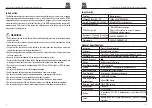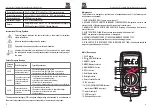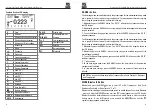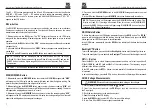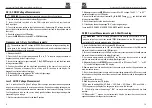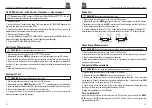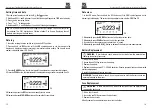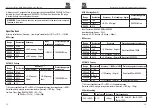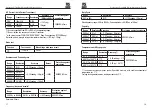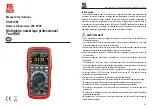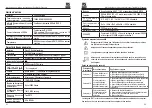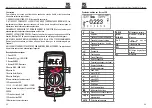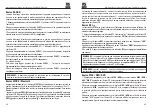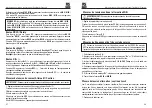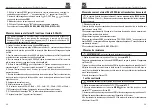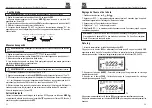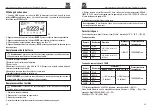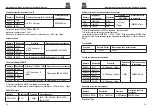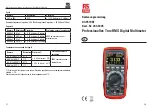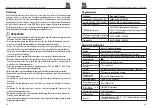
9
10
DC / AC Milli Voltage Measurements
WARNING
:
Observe all safety precautions when working on live voltages.
1. Set the rotatory function switch to the
mV
position.
2. Insert the black test lead into the COM input jack and the red test lead into
the V input jack.
3. Touch the test lead probes to the circuit under test. If measuring DC voltage, touch the
red test lead to the positive side of the circuit and the black test lead to the negative side of
the circuit.
4. Read the voltage on the LCD display,
5. press the
MODE
button to select DC or AC
Milli
voltage.
Frequency and % Duty Cycle Measurements
The maximum input AC voltage is 1000V. Do not measure voltages exceeding the
limits given in this manual. Exceeding voltage limits could result in electrical shocks to
the user and damage to the instrument.
1. Select position Hz%.
2. Press the Hz% key to select measurements “
Hz
” or “
%
” in order to display the values of
frequency and duty cycle of input voltage.
3. Insert the red cable into input terminal
V Hz% CAP Temp
and the black cable
into input terminal
COM
.
4. Position the red lead and the black lead respectively in the spots of the circuit to be
measured . The value of frequency (Hz) or of duty cycle (%) is shown on the display. The
bargraph is not active in these functions.
5. If the display shows the message "
OL
", select a higher range.
6. To use the HOLD and HIRES function.
Low Z AC/DC Voltage Measurement
Low Z is used to check for “ghost” voltage. Ghost voltages are present when non-powered
wires are in close proximity to wires powered wires. Capacitive coupling between wires
make it appear that non-powered wires are connected to a real source of voltage. The Low
Z setting places a load on the circuit, which greatly reduces the voltage reading when
connected to ghost voltage.
1. Set the rotary function switch to the
Low Z
position.
Professional True RMS Digital Multimeter/ English
2. Momentarily press the
MODE
button to select AC or DC voltage. The AC “~” or DC “ ”
symbol will appear on the LCD display.
3. Insert the red cable into input terminal
V Hz% CAP Temp
and the black cable
into input terminal
COM
.
4. Touch the test leads to the circuit under test.
5. If the display shows the message "
O.L
", select a higher range.
To use the HOLD, RANGE, MAX MIN, PEAK, HIRES and REL functions
AC/DC Current Measurements and 4-20mA% reading
WARNINGS
: Observe all safety precautions when working on live circuits. Do not
measure current on circuits that exceed 1000V. Measurements in the 10A range should
be limited to 30 seconds maximum every 15 minutes.
1. Insert the black test lead into the negative
COM
input jack.
2. For current measurements up to 10A, set the rotary function switch to the
10A
position
and insert the red test lead into the
10A
input jack.
3. For current measurements up to 600mA, set the rotary function switch to the
mA
position
and insert the red test lead into the
µA mA
input jack.
4. For current measurements up to 6000µA, set the rotary function switch to the
µA
position and insert the red test lead into the
µA mA
input jack.
5. Momentarily press the
MODE
button to select AC or DC current. The AC “~” or DC
“ ” symbol will appear on the LCD display.
6. Remove power from the circuit under test, then open up the circuit at the point where you
wish to measure current.
7. Touch the test lead probes in series with the circuit being measured. For DC current, touch
the red probe to the positive side of the circuit and touch the black probe to the negative side
of the circuit.
8. Apply power to the circuit.
9. Read the current on the LCD display.
10. The value of reading 4-20mA% (0mA = -25%, 4mA = 0%, 20mA = 100% and 24mA =
125%) appears on the display. The bargraph is not active in this function.
11. If the display shows the message “
O.L
”, the maximum measurable value has been
reached.
12. When symbol "-" appears on the instrument's display, it means that current has the
opposite direction with respect to the connection.
Professional True RMS Digital Multimeter/ English
Summary of Contents for 204-8305
Page 48: ......


